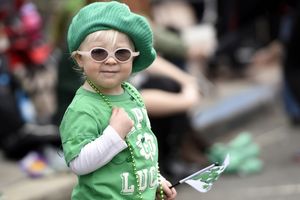![AP ST. PATRICK PARADE A USA NJ [image : 81869670]](http://www.gannett-cdn.com/media/2016/03/16/USATODAY/USATODAY/635937371522873572-AP-St.-Patrick-Parade.jpg)
Get out your green! It's St. Patrick's Day. USA TODAY Network explains the origins of some of the Irish holiday's traditions.
![6 fun facts about St. Patrick's Day [video : 81903080]](http://videos.usatoday.net/Brightcove2/29906170001/2016/03/29906170001_4805253820001_ST-PATTY-FOR-ANGELA.jpg?pubId=29906170001)
1. Who was St. Patrick?
St. Patrick — brace yourself — was not actually Irish. Patrick was a nobleman born in about 400 A.D. in Britain and kidnapped by Irish pirates at the age of 16, said Philip Freeman, author of St. Patrick of Ireland: A Biography.
Patrick was born into a religious family, but was an atheist early in his life. However, he rediscovered his faith while enslaved in Ireland, Freeman told USA TODAY Network.
After 17 years as a slave, St. Patrick escaped Ireland and found his way home, but returned to Ireland as a missionary.
"He said he was ready to die in Ireland in order to make his mission successful," Freeman said.
It's unclear if St. Patrick did in fact die in Ireland, but March 17 is widely believed to be the day of his death, according to Freeman.
2. Green River in Chicago is a family affair:
Another unique tradition that has grown in popularity every year is the annual dyeing of the Chicago River for St. Patrick's Day.
If you've never had the chance to see it, you can watch a timelapse here:
![Chicago River Dyeing Green - St. Patrick's Day Celebration 2016 4K Time Lapse [oembed : 81900594] [oembed : 81900594] [oembed : 81900594] [oembed : 81900594] [oembed : 81900594] [oembed : 81900594]](/Portals/_default/Skins/PrestoLegacy/CommonCss/images/smartembed.png)
The Butler and Rowan family clans are responsible for turning the murky water bright green, and they've done it for more than 50 years.
The only way to become part of the six-person boat crew is to be related by blood or marriage to either Mike Butler or Tom Rowan, according to The Chicago Tribune. Each year, the crew shakes an orange powder — a top secret recipe — into the Chicago River from a sifter and it stays green for about five hours.
3. Parades
St. Patrick's Day began as a religious holiday in Ireland but became a celebratory affair because of Irish Americans, according to Timothy Meagher, a history professor at Catholic University in D.C.
In the United States, St. Patrick's Day was first celebrated with banquets at elite clubs in Boston, Philadelphia, New York, Charleston, S.C., and Savannah, Ga., Meagher said.
New York City hosted the first St. Patrick's Day parade in 1762, and by the mid-19th century parades were common, he said.
"The parades are a statement of showing our colors, showing our numbers, showing that we are powerful and important," Meagher said of the role of parades in celebrating Irish-American identity.
4. Shamrocks
Legend has it that St. Patrick used the three-leaved shamrock to explain the Christian Holy Trinity.
But Freeman said, "There's no evidence St. Patrick ever did that."
Traditions as early as the 17th century incorporated the plant, said Mike Cronin, author of Wearing the Green: A History of St. Patrick's Day.
People wore shamrocks on their coats and closed the day by "drowning the shamrock" — placing it in a glass of whiskey before drinking, Cronin said.
5. Gobs and gobs of Guinness:
The Irish stout is the drink of choice on St. Patrick's Day.
On a typical day, Americans drink about 600,000 pints of the Dublin-based beer. But on St. Patrick's Day, about 3 million pints of Guinness are downed, according to Guinness in an email to USA TODAY Network.
Planning on drinking a pint on Monday? Tips from Guinness on the perfect pour: Tilt the glass at 45 degrees when pouring until it is three-quarters full, then let the beer settle before filling the glass completely to the top.
Analysts are predicting that 13 million pints of Guinness will be consumed worldwide, during this year's holiday.
6. Leprechauns
Today's leprechauns, usually rosy-cheeked, boozy little men in green attire, come from Irish folklore.
The first recorded mention of a leprechaun goes back to the 8th century, coming from the word luchorpán, meaning "little body" to describe water spirits, according to John and Caitlin Matthews in The Element Encyclopedia of Magical Creatures.
Another possible origin is the Irish god Lugh, whose Welch variant is known as one of the "Three Golden Shoemakers."
There's also the Irish fairy Cluricaune, "a cunning spirit who haunts cellars, drinks, smokes and plays tricks," the Matthewses write. Cluricaune was popularized in a 1825 publication called Fairy Legends.
7. Corned beef and cabbage
Although a classic St. Patrick's Day meal, corned beef and cabbage is more American than Irish.
Irish Americans in the 19th century were mostly poor. The most affordable meat available was corned beef, according to Cronin.
And cabbage? "It's a spring vegetable and it's cheap," Cronin said.
Here's more on St. Patrick's Day:
Throwing a party?
![13 tips for throwing a St. Patrick's Day party on a budget [oembed : 81900564] [oembed : 81900564] [oembed : 81900564] [oembed : 81900564] [oembed : 81900564] [oembed : 81900564]](/Portals/_default/Skins/PrestoLegacy/CommonCss/images/smartembed.png)
St. Patty's Day Caribbean style
![Island greenery: St. Patrick's Day celebrations in the Caribbean [oembed : 81900568] [oembed : 81900568] [oembed : 81900568] [oembed : 81900568] [oembed : 81900568] [oembed : 81900568]](/Portals/_default/Skins/PrestoLegacy/CommonCss/images/smartembed.png)
Contributing: Teresa Blackman, KGW-TV
![St. Patrick's Day [videoplaylist : 81902678]](http://videos.usatoday.net/Brightcove2/29906170001/2016/03/29906170001_4805253820001_ST-PATTY-FOR-ANGELA.jpg?pubId=29906170001)


